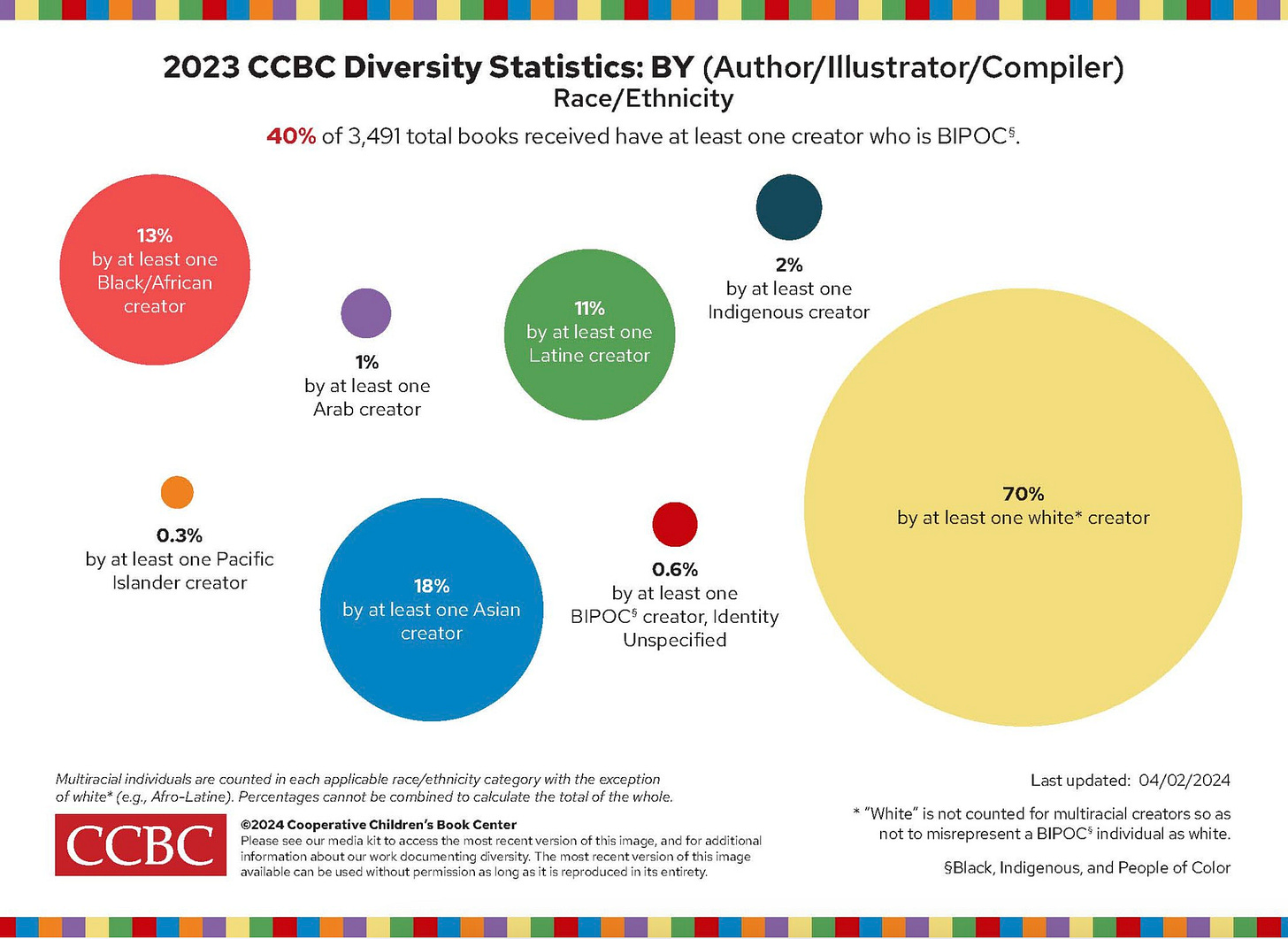Mind the Awards Gap
Despite representation gains in recent years, racial and gender disparities persist in award-winning children's literature.
There is much to celebrate about the progress in diversity in children's and teen literature today compared to a decade ago, especially in terms of racial representation.
After all, following a long period of inertia, it was only in 2015 that the number of children’s books by BIPOC creators and about BIPOC characters began to increase, before tripling in 2020.
This is a win, but quantity only takes you so far.
The most influential children’s stories (i.e., the award winners) continue to over-represent non-Hispanic white males, as published in a study performed by the Quarterly Journal of Economics.
Let’s unpack that.
First, the good(-ish) news.
While year-over-year improvements in representation were modest, they’re at least trending in the right direction.
Thanks to recently updated documentation by the Cooperative Children’s Book Center (CCBC) through its annual Diversity Statistics data, we know the following stats about kids and teen books published in 2023:
49% of the books documented had significant BIPOC content1, up from 46% in 2022.
Here is a more detailed breakdown, which also includes data about disability, minority religion and LGBTQ+ representation. The CCBC only started tracking these additional aspects of identity in 2018.
40% of the books documented had at least one BIPOC primary character, up from 39% in 2022.
It continues to be interesting to see there were more books written about animals than there were about Blacks/Africans, for example.
40% of the books documented were created by at least one person of color as author, illustrator or compiler, flat to 2022.
By comparison, 70% of the books documented had at least one white creator.
But despite the uptick we’ve seen over the last several years in diverse books, the most prestigious prizes in kids’ literature are still going to stories that heavily feature non-Hispanic white males.
This was the case in every single book category, including those with a diversity focus!

Winning a major award in children's literature is more than just an honor; it is a path to broader acceptance and visibility.
The Newbery and Caldecott Medals are widely considered the most elite awards in kids' literature. They are a gateway to broadened reach and cultural impact, and can catapult a book into the mainstream and significantly boost its readership.
When accolades bring critical and commercial success, they ensure that more children have access to these stories. As diverse books win awards, they validate the experiences of those who see themselves in these stories and introduce other readers to perspectives they might not otherwise encounter.
There are a myriad of possible reasons for the disparities in recognition for diverse books—including legacy bias, lack of development opportunities for minority artists, and structural issues.
Here are our hypotheses:
Potential Bias
Implicit Bias Among Judges:
Even with the best intentions, judges may unconsciously favor stories and perspectives that resonate with their own experiences, which can perpetuate the status quo.
Cultural Gatekeeping:
The literary community, including publishers, critics, and award committees, often comprises individuals from similar backgrounds. This homogeneity can lead to a narrow definition of what constitutes "literary excellence," inadvertently excluding diverse voices.
Lack of Development Opportunities for Minority Artists
Fewer Resources and Support:
Minority authors and illustrators often have less access to mentorship, funding, and networking opportunities. This lack of support can hinder their ability to refine their craft and gain visibility in the literary community.
Publishing Industry Barriers:
The publishing industry has historically been dominated by white professionals, which can create barriers for minority creators. This includes fewer opportunities for their work to be picked up by major publishers, promoted effectively, or reviewed by influential critics.
Limited Representation in the Backlist:
Prestigious awards often consider an author’s previous work and reputation. Since minority authors have been underrepresented in the past, they may not have the extensive backlists that award committees often favor.
Structural Issues
Narrow Award Criteria:
Award criteria might favor traditional narratives or styles that do not align with the innovative or culturally specific storytelling techniques often found in diverse literature.
Marketing and Visibility:
Books by traditional authors might receive more marketing support and thus greater visibility. This increased exposure can influence judges who are more likely to encounter and consider these works for awards.
What does this mean for Moonbeam?
Addressing these disparities requires intentional effort. We are dedicated to amplifying underrepresented voices, fostering an artist-forward approach, and focusing on the career development and robust support of our literary clients and their stories—which we will also expand widely into the world of media.
We believe that diversity in children's and teen literature is not just a trend, but a fundamental aspect of creating a more inclusive society. By highlighting the achievements and addressing the challenges faced by diverse authors and illustrators, we can contribute to a more equitable literary and media landscape.
Thanks for reading,
Jesse & Rebecca
Significant BIPOC content is defined as having a primary or significant secondary character or human subject who is BIPOC, or the setting or topic of the book relates to BIPOC people or history







